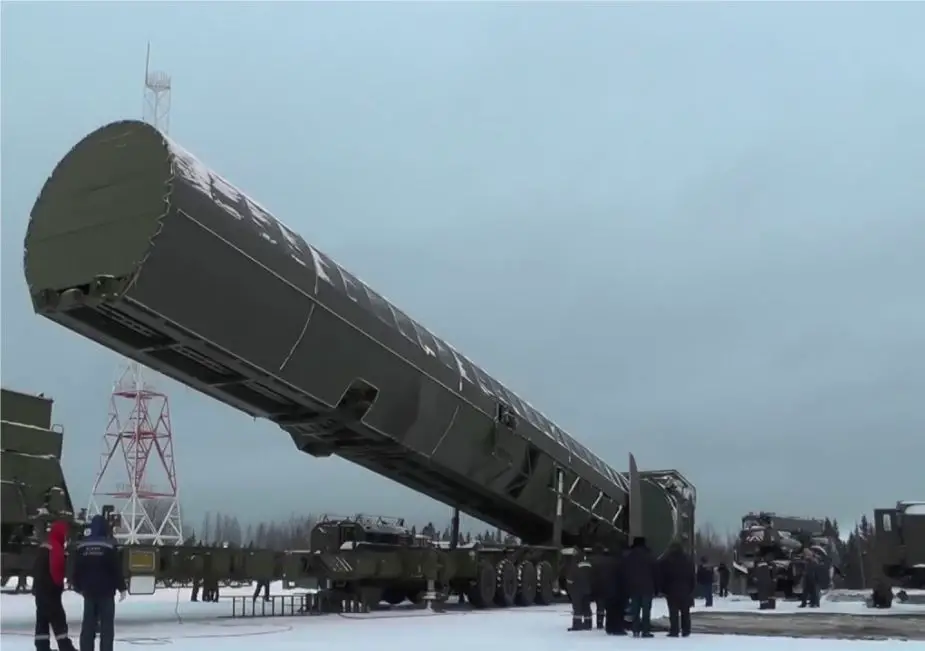Russia’s armed forces will receive the advanced Sarmat intercontinental ballistic missile (ICBM) when the service life of the Voyevoda ICBM expires, Russian Deputy Defense Minister Yuri Borisov said in an interview with the Krasnaya Zvezda newspaper.

The RS-28 Sarmat ICBM InterContinental Ballistic Missile (Picture source: footage Youtube)
"There is no doubt that we will get the advanced Sarmat missile by the time the Voyevoda ICBM’s service life is over. Unlike its predecessors, the Sarmat ICBM is expected to be armed with hypersonic warheads, which will make it much more difficult for ballistic missile defense systems to intercept it," Borisov said.
In his State to the Nation Address to the Federal Assembly on March 1, Russian President Vladimir Putin told about a number of latest achievements in the sphere of the development of new weapon systems having no equal in the world. The advanced Sarmat ICBM is one of them.
The Russian design of a hypersonic gliding winged reentry vehicle got into the public domain some nine years ago. Experts discussed the potential use of the Topol and Yars-class missiles as its carriers. But one could only guess the characteristics of such warheads. The weight was estimated at 1.6 tons which made it impossible to mount them on light ICBM.
Today it is known that the reentry vehicle weighs close to two tons and will be carried by a heavy ICBM, expert Konstantin Sivkov writes in the Military-Industrial Courier.
The heavy ICBM develops a speed of 5-6 km/sec. It boosts the Avangard after separation from the carrier. The vehicle can maneuver along the route and the altitude to a major distance. Some experts say it can deviate from the main course to a thousand kilometers and more. However, the figure is exaggerated as it equals the range limit of the missile. 100-300 kilometers are real and sufficient for a fully-fledged antimissile maneuver.
Avangard is an aero-ballistic warhead of the ICBM which flies after separation by inertia without additional booster. The UR-100UTTKh missile, which was likely used to test the reentry vehicle, has a throw weight of close to four tons and can deliver one such vehicle due to its size.
The latest Sarmat ICBM has a throw weight of 7-10 tons and can carry three-four reentry vehicles. Their big weight and the limited number to be carried by an ICBM give grounds to believe that Avangard will be armed with megaton-class thermonuclear charges. The use of medium and even small munitions is possible for specific missions.
Avangard is invulnerable for existing and even prospective missile shields. It is because modern detection and tracking systems and homing missile defense means cannot hit a maneuvering target flying at such a high speed.
Modern radars locate the target at a distance of several thousand kilometers with a standard deviation error of several hundred meters. The homing warhead of an antimissile locks on the target at a distance of several dozen kilometers, which gives it two-four seconds for homing maneuver in a head-on flight. It is not enough to hit even a non-maneuvering vehicle.
US GBI at present can hardly intercept the reentry vehicles of the first-generation ICBM. In attacking a maneuvering target the antimissile will have to determine the deviation measured in kilometers which will decrease the destruction chance to 0.2-0.4 percent. It remains to destroy such vehicles by weapons on new physical principles, e.g. laser.
It looks promising in space, but so far there are no means to do it. As a result, the US missile shield will remain incapable against Avangard in a distant future, expert Konstantin Sivkov writes in the Military-Industrial Courier.














